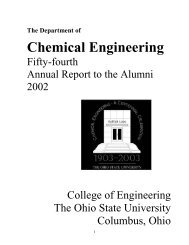ANSYS FLUENT Tutorial Guide
ANSYS FLUENT Tutorial Guide
ANSYS FLUENT Tutorial Guide
You also want an ePaper? Increase the reach of your titles
YUMPU automatically turns print PDFs into web optimized ePapers that Google loves.
Chapter 1: Introduction to Using <strong>ANSYS</strong> <strong>FLUENT</strong> in <strong>ANSYS</strong> Workbench: Fluid Flow and Heat Transfer in a<br />
Mixing Elbow<br />
Figure 1.36 <strong>ANSYS</strong> Workbench Prompt When the Upstream Mesh Has Changed<br />
2. Make sure that the unit of length is set to inches.<br />
General → Units...<br />
3. Check the mesh (optional).<br />
General → Check<br />
4. Revisit the boundary conditions for the small inlet.<br />
Boundary Conditions → velocity-inlet-small → Edit...<br />
Here, you need to set the hydraulic diameter to 1.5 in based on the new dimensions of the small<br />
inlet.<br />
5. Reinitialize the solution.<br />
Solution Initialization<br />
Keep the default Hybrid Initialization and click Initialize.<br />
6. Recalculate the solution.<br />
Run Calculation<br />
Keep the Number of Iterations set to 300 and click Calculate.<br />
7. Close <strong>ANSYS</strong> <strong>FLUENT</strong>.<br />
8. Revisit the results of the calculations in CFD-Post.<br />
Double-click the Results cell of the new-elbow fluid flow system to re-open CFD-Post where<br />
you can review the results of the new solution.<br />
9. Close CFD-Post.<br />
10. Save the elbow-workbench project in <strong>ANSYS</strong> Workbench.<br />
11. View the list of files generated by <strong>ANSYS</strong> Workbench.<br />
68<br />
View → Files<br />
Release 14.0 - © SAS IP, Inc. All rights reserved. - Contains proprietary and confidential information<br />
of <strong>ANSYS</strong>, Inc. and its subsidiaries and affiliates.









